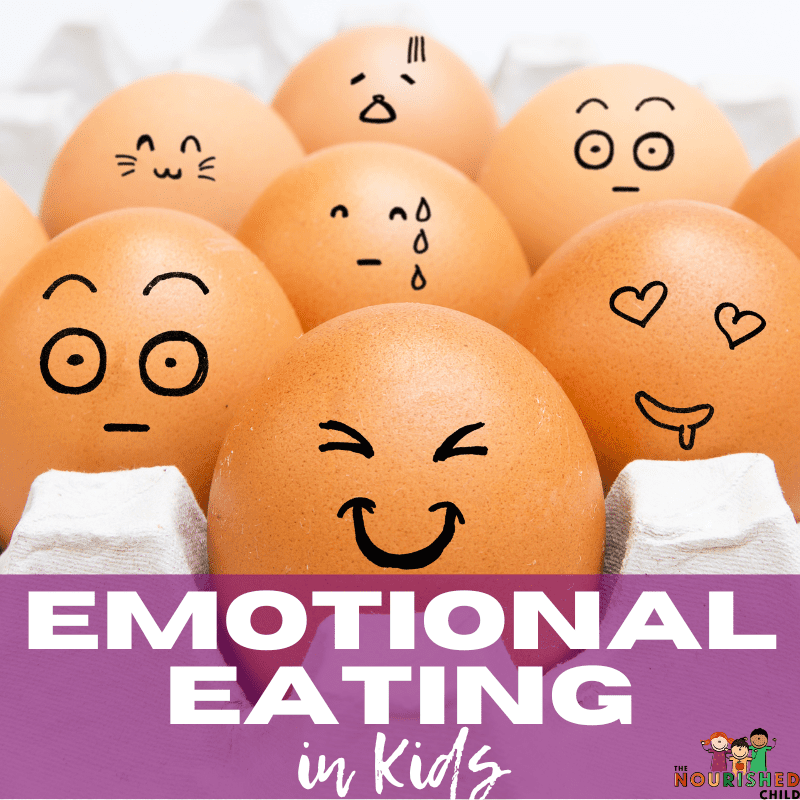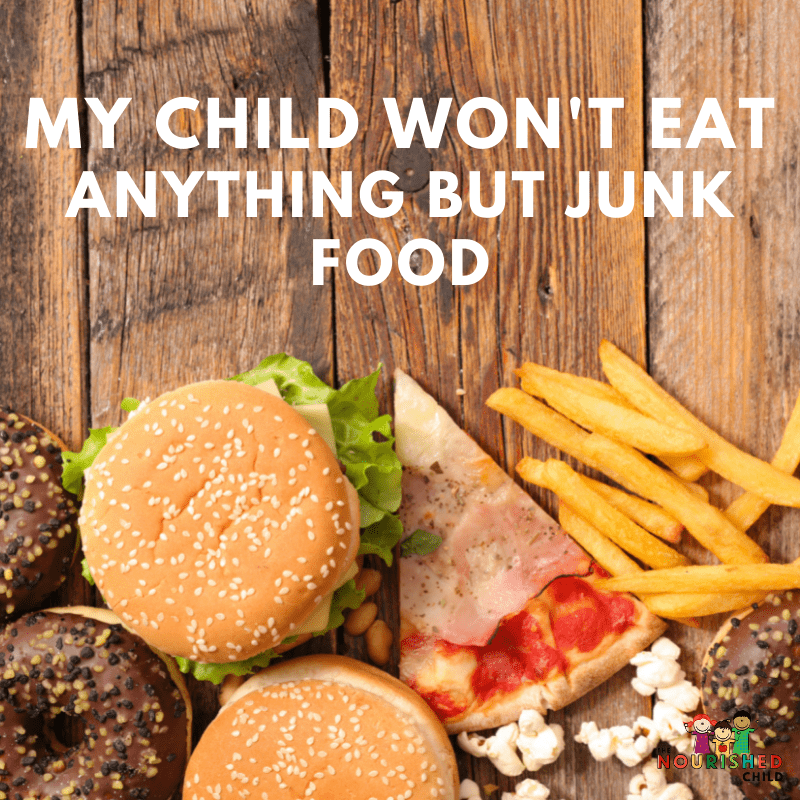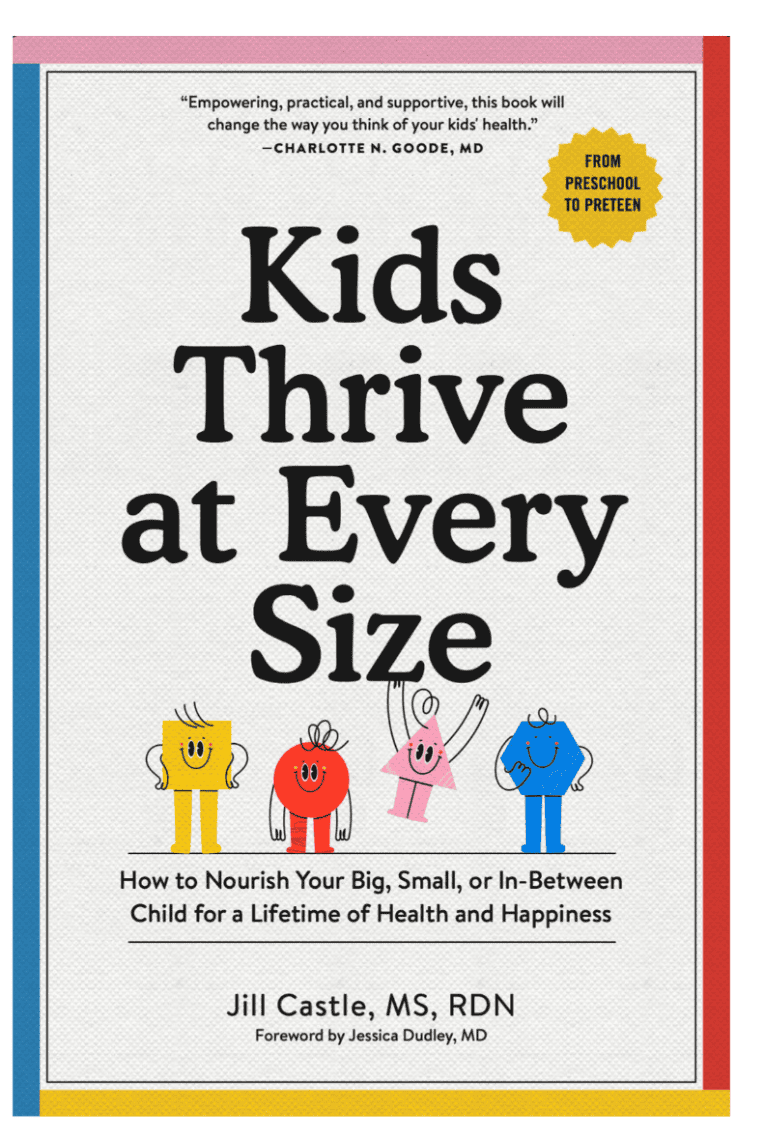Emotional Eating in Children: When Kids Cope with Food
October 2, 2024
Emotional eating doesn’t only affect adults. Children also may eat for reasons other than physical hunger even though they are usually more in touch with their hunger cues than adults. Keep reading to learn why kids may cope with food and what parents can do to help!
Do you suspect your child is an emotional eater, eating more food than usual to cope with challenging emotions?
Growing children eat more and frequently when they’re going through a growth spurt. So, it can be difficult for parents to tell if a child is eating due to emotional hunger versus physical hunger. Some kids may not have the language to explain how they feel, and why they’re eating. Sometimes a parent’s effort to help can actually make things worse.
In this article, I cover the signs of emotional eating in kids and how you can help them overcome it (and the one thing you shouldn’t do).

What Is Emotional Eating?
Emotional eating is eating for reasons other than physical appetite.
Children may eat to soothe or suppress negative emotions such as anger, fear, loneliness, boredom or sadness.
Many people don’t realize they eat as a coping mechanism even though they’re eating when not hungry.
Kids may eat because food is tasty and looks good, they have a pleasant memory of liking it, or they may be using food to numb negative emotions or an emotional state.
Or for any other reason in between: boredom, anxiety, stress, anger and yes, even positive emotions like happiness.
How do you know if your child is eating out of emotional need?
Emotional Hunger vs. Physical Hunger
Most people think of hunger cues as a rumbling stomach. However, not everyone’s early signs of hunger are the same. Some people describe hunger as feeling “empty” or a drop in energy.
Here are a few hunger signs you might notice in your child:
- cranky, or having mood swings
- low energy or fatigue
- stomach growling
- unable to concentrate
- headache
If you’re not sure, you can ask your child age-appropriate questions to find out. For young children, you might ask if their belly is hungry or if their mouth is hungry.
Older children can describe how they feel. Even infants can learn to use sign language to describe hunger and fullness.
Sometimes kids may be physically hungry even if they recently ate. Every day and every child is different.
The signs of emotional overeating depend on what may be triggering a child to eat as a way to soothe negative emotions.
Here are a few signs to look for:
- Certain patterns like watching TV trigger cravings
- Your child is sneaking or hiding food
- Eating while distracted (studying or gaming)
- Increased weight
- Using food to soothe when upset or sad
What Causes Emotional Eating?
Kids may seek food because it’s tasty, or it helps ease strong negative emotions they don’t know how to express or don’t have skills yet to self-regulate.
Environmental factors play a role. One study found that kids from noisy and disorganized homes were more likely to eat emotionally.
But parental feeding practices are another factor in children’s eating behavior. In the same study, children with responsive mothers at mealtime tended not to eat emotionally despite chaos.
A few triggers for emotional eating include:
- Household chaos
- Stress and stressful events
- Boredom
- Loneliness
- Food restriction
- Distraction
- Childhood traumas
What Are the Risks of Emotional Eating?
The number one question I get from parents is should they be worried if their child eats emotionally. Emotional eating alone is not immediately harmful to your child. The truth is most people use food to cope with their emotions at some point.
Occasionally using comfort food to feel soothed or enjoying food at celebrations and holidays even when not hungry, doesn’t always mean a child has a problem with food.
However, when a child tends to associate food with soothing negative emotions, there may be some long-term risks including:
- A learned behavior of relying on food instead of coping with difficult emotions in positive ways
- Higher risk of developing an eating disorder such as Binge Eating Disorder
- Increased body fat gain which can lead to early puberty (the good news is that kids can grow into their weight, so the answer isn’t restriction), and other health problems
- Depression and other psychological problems
One study found mental health consequences of emotional eating, like depression and the inability to regulate emotions.
Emotional eaters may experience weight gain. Dieting or calorie restriction is not the solution. Learning emotion regulation, however, is.
How to Help Kids Overcome Emotional Eating
The first thing parents can do is to help their children identify the emotional reasons for eating. What is causing negative feelings? Once the trigger is identified, you can find healthier ways to cope.
The one thing parents should never do is restrict access to food. Food restriction often triggers an emotional response and the desire to eat more food. Restriction isn’t just limiting portions or keeping sweets and treats under lock and key. It can be negative comments about food and weight, which may be perceived as restriction.
I know it’s hard to not say anything, but as a pediatric dietitian, I see the outcome of negative feeding practices and interactions, including eating disorders, low self-esteem, and secret eating.
Instead, feeding a child with love and limits creates a positive home environment, which is essential to developing a child’s healthy relationship with food.
These are some of the best strategies to try instead:
- Set routines and guidelines. Establish eating routines such as regular mealtimes, and guidelines like the ‘kitchen is closed.’ Gently explain the reasons for your routines. However, do not include a child’s body size as a reason.
- Encourage trust and self-regulation. Teach and ask your child to follow their hunger and fullness cues so they can regulate their eating. Remember, it’s a learning curve!
- Eat mindfully. Teach children to eat mindfully by slowing down, focusing on the taste of food, and what the food feels like in their mouth. You even can point out that food tastes better when they’re actually hungry.
- Yoga or relaxation exercises. Stress and anxiety are major triggers for emotional eating. Provide your child with other options to cope with these big emotions.
- Have fun. Instead of turning to food when kids are bored and lonely, give them activities and make plans for play dates.
- Cognitive Behavior Therapy (CBT) for emotional eating. Some kids may need a little more support to learn how to regulate their emotions.
Help for Emotional Eating
A positive feeding home environment can help kids re-learn how to trust their body’s hunger and fullness signals and self-regulate their eating.
Some kids may need a little extra support from eating behavior experts such as a pediatric dietitian and a counselor that has experience working with children. Consult with your primary care physician if this is the case.
If you would like more guidance with applying positive family feeding strategies, get my mini-training and learn how to help your child and family build a better relationship with food.
Related Read: 10 Reasons Your Child Eats Too Much

Jill Castle, MS, RD
I like empowering parents to help their children and teens thrive at every size with realistic advice centered on healthful habits around food, feeding, nutrition and health behaviors. As a pediatric dietitian and author, my goal is to share strategies and realistic advice to help you raise a healthy and happy child through my articles and podcast.




